Utah is home to both well-known dinosaurs and some of the rarest and most remarkable finds in paleontological history. With new species being unearthed and named every year, it’s no wonder that the state is a hotbed for dinosaur discovery. Below, we’ll look at 10 dinosaurs that once lived in Utah, and where to see fossils today!
1. Dystrophaeus
This enormous herbivore can be traced back to the Kimmeridgian Age of the Late Jurassic Period — approximately 155 million years ago. Fossils from Dystrophaeus viaemalae were first discovered in Utah’s Morrison Formation by John Strong Newberry back in 1859. Dystrophaeus was the first sauropod described from the West and the first dinosaur named from Utah.
However, Newberry and his team did not have the tools to fully excavate the massive dinosaur. In addition, the terrain was extremely difficult, and the location of the site was somehow lost over time. In fact, it would be another 155 years before a paleontology team would attempt to excavate Newberry’s original Dystrophaeus.
2. Martharaptor
The unique Martharaptor was discovered and first described by the state paleontologist Jim Kirkland and his colleagues in Utah in 2012. This dinosaur was aptly named after one of Kirkland’s team members, Martha Hayden. The partial skeleton of the Martharaptor comes from Cretaceous rocks of the Cedar Mountain Formation in Utah. Scientists still do not know a lot about this peculiar dinosaur, but such a recent discovery in Utah certainly is exciting. Who knows what else they may unearth in the coming years!
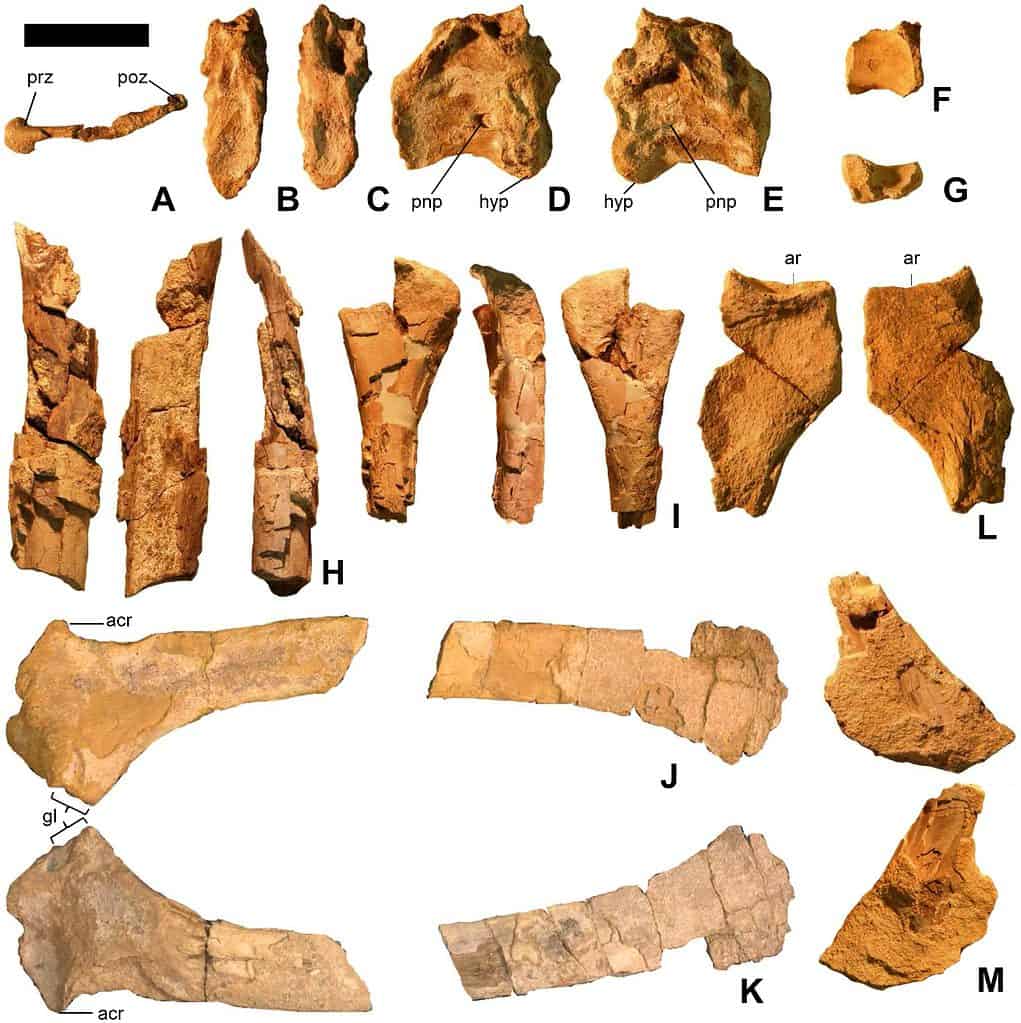
©Phil Senter, James I. Kirkland & Donald D. DeBlieux, CC BY 2.5 <https://ift.tt/BuSol4f>, via Wikimedia Commons – License
3. Akainacephalus
Another recent discovery in Utah is the state’s first ankylosaurid (a type of armored dinosaur with a tail club). Fossils from Akainacephalus johnsoni were found in southern Utah’s Grand Staircase-Escalante National Monument, and date back to the Late Cretaceous Period.
Described in 2018, this herbivorous dinosaur had a heavy armor-like covering, which helped protect it from predators. Akainacephalus comes from two Greek words, “akaina” and “cephalus”, which mean “thorn” or “spike” and “head”. Its powerful tail club along with its robust body further aided in warding off potential threats. Estimates put the Akainacephalus as being 3.5 feet tall and 13 to 16 feet long.
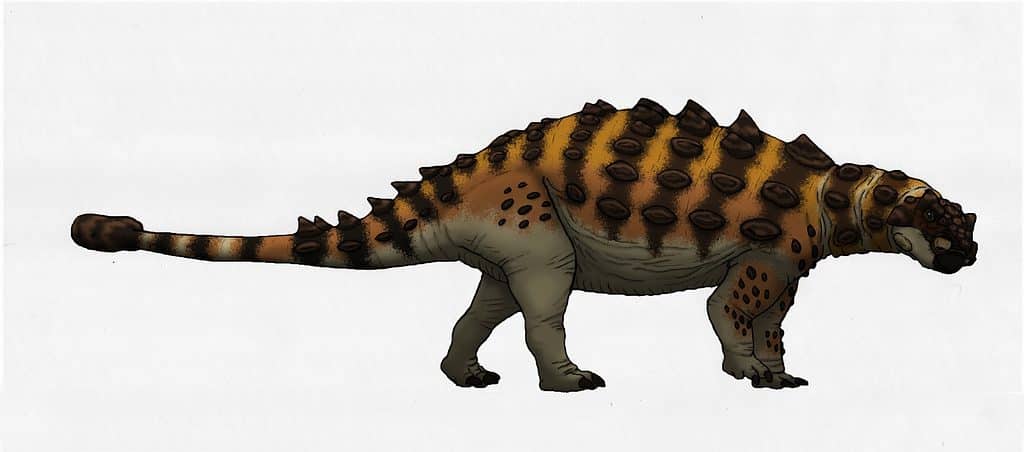
©Juan(-username-), CC BY-SA 4.0 <https://ift.tt/zfNXQh9>, via Wikimedia Commons – License
4. Moabosaurus
This herbivorous long-necked dinosaur was discovered near Moab, Utah, in the Cedar Mountain Formation. The fossil record of this creature is impressive. Researchers found over 5,000 bones in Dalton Wells Quarry outside of Moab, according to their 2017 report. Notable for its size, Moabosaurus was one of the largest dinosaurs in North America. It measured approximately 33 feet, and possibly even longer!
Due to its heavily-armored body and large size, Moabosaurus likely had few predators. It moved around on four sturdy legs, with a long neck and tail helping it balance its immense weight. Scientists believe that Moabosaurus provides important insight into the evolution of sauropod dinosaurs in this region of North America.
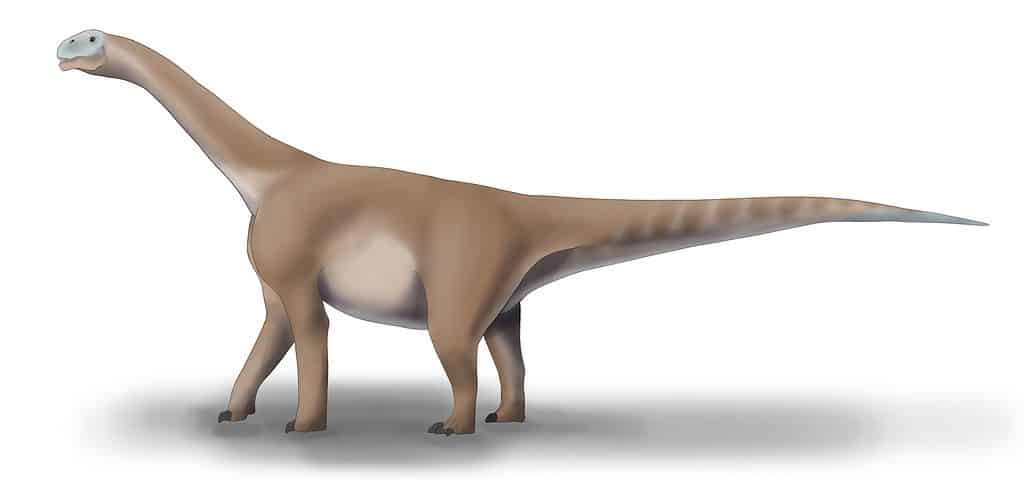
©Audrey.m.horn, CC BY-SA 4.0 <https://ift.tt/zfNXQh9>, via Wikimedia Commons – License
5. Utahraptor
The official state dinosaur of Utah is the Utahraptor, which is actually a different species than the official state fossil (don’t worry, we’ll look at that one next). Utahraptor ostrommaysi was a half-ton predator from the Early Cretaceous Period with sickle claws. Even just one of its deadly claws was around 9.5 inches long!
Scientists believe that the Utahraptor hunted in packs, was at least 20 feet long, and weighed over 600 pounds. Remains of this creature were found near Moab, Utah, in the Dalton Wells Quarry. The College of Eastern Utah Prehistoric Museum in Price, Utah, is home to an assembled skeleton.
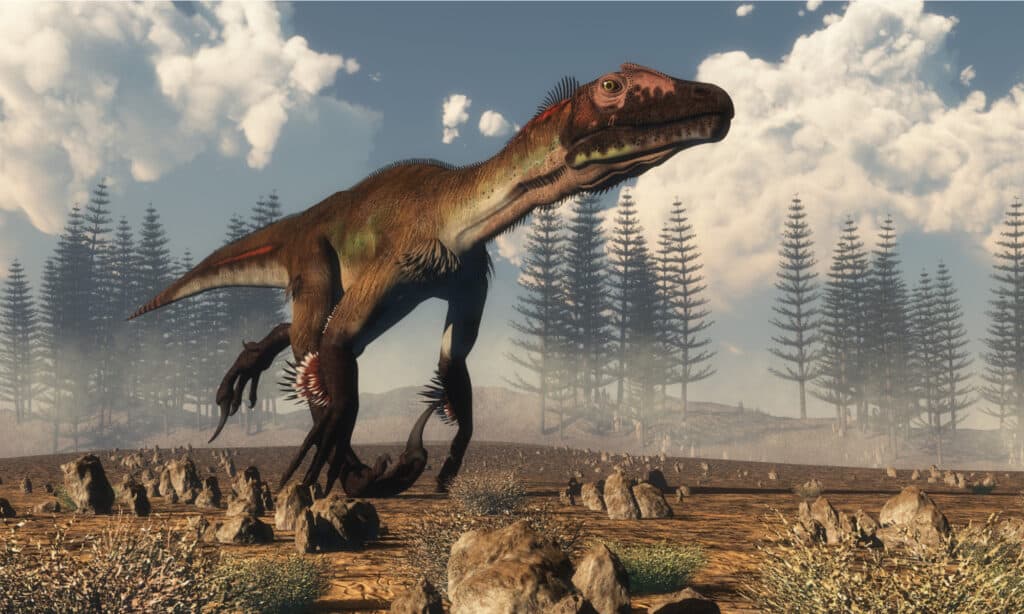
©Elenarts/Shutterstock.com
6. Allosaurus
Not to be confused with the state’s official dinosaur, the Allosaurus is Utah’s official state fossil. Allosaurus fragilis was a large carnivorous dinosaur that lived around 150 million years ago during the Late Jurassic Period. It was one of the most common predators of its time in the Morrison Formation in Utah.
The Allosaurus was a massive two-legged predator, measuring approximately 25 to 35 feet long. It had a light yet durable skull lined with dozens of sharp, serrated teeth. This ferocious predator would hunt in packs to take down much larger prey than itself as well as other Allosaurus dinosaurs.
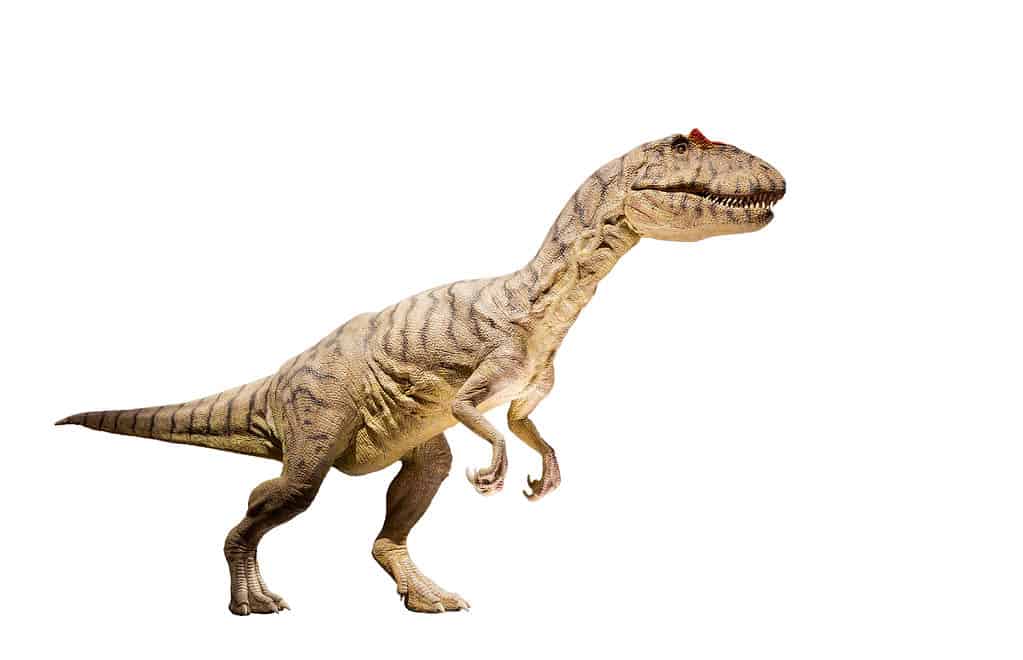
©Lefteris Papaulakis/Shutterstock.com
7. Stokesosaurus
This rare, carnivorous dinosaur lived around 152 million years ago during the Jurassic Period. James Henry Madsen and William Lee Stokes discovered its remains in the 1970s. Madsen named the new dinosaur Stokesosaurus clevelandi after Stokes, and the Utah town of Cleveland, where they found the fossils.
Stokesosaurus was part of the tyrannosaur family and is actually an ancestor to the mighty Tyrannosaurus rex! However, you wouldn’t guess it based on its size — Stokesosaurus clevelandi only grew around 10 to 13 feet long! This smaller size allowed it to hunt faster prey. It was quicker and more agile than the larger predators like the Allosaurus. Its speed also made it harder for the bigger dinosaurs to catch.
8. Machairoceratops
Paleontologists discovered the rather unique Machairoceratops in the Late Cretaceous Wahweap Formation of the Grand Staircase–Escalante National Monument in southern Utah. This unusual dinosaur had long, sword-like horns protruding from the shelf of bone on the back of its skull, making it a rare and remarkable sight among other horned dinosaurs.
Scientists named the Machairoceratops in 2016 for its two forward-curving horns on the shelf of bone at the back of its skull. Its generic name comes from the Greek and Latinized Greek words “machairis” and “ceratops”, meaning “bent sword” and “horned face”. The specific name, Machairoceratops cronusi, refers to Cronus, a Greek god who castrated his father Uranus with a curved blade, similar to a sickle or scythe.

©Nobu Tamura email:nobu.tamura@yahoo.com https://ift.tt/7w3Qr85 https://ift.tt/YSjLGoO / CC BY-SA 4.0 – License
9. Iguanacolossus
In 2005, Donald D. DeBlieux made a remarkable and historic discovery when he unearthed the fossilized remains of Iguanacolossus from the Yellow Cat Member of the Cedar Mountain Formation in Utah. This unique, spike-thumbed herbivore lived during the Early Cretaceous Period, roaming across North America.
Iguanacolossus was a very large and strong dinosaur. It was probably around 30 feet long and weighed around 11,000 pounds! Its scientific name, Iguanacolossus fortis, comes from three different words. “Iguana” because it has teeth like an iguana, “colossus” for its enormous size, and “fortis“, which means mighty. So, Iguanacolossus fortis means giant and mighty iguana!

©Lukas Panzarin, CC BY 2.5 <https://ift.tt/BuSol4f>, via Wikimedia Commons – License
10. Apatosaurus
Many people call this enormous dinosaur the Brontosaurus, but its true name is the Apatosaurus. This behemoth was over 75 feet long and weighed over 30 tons (comparable to that of six average elephants). It was one of the largest creatures to have ever walked on planet earth! Apatosaurus is probably the best-known of all the four-legged and long-necked sauropod dinosaurs. It was an enormous quadrupedal dinosaur of the Jurassic Period with four impressively large and pillar-like legs and an incredibly long, whiplike tail.
The name Apatosaurus is a combination of two Greek words, “apatē” and “sauros”, meaning “deceptive” and “lizard”. This impressive dinosaur gets its name from its chevron bones, which are unlike those of any other dinosaur.
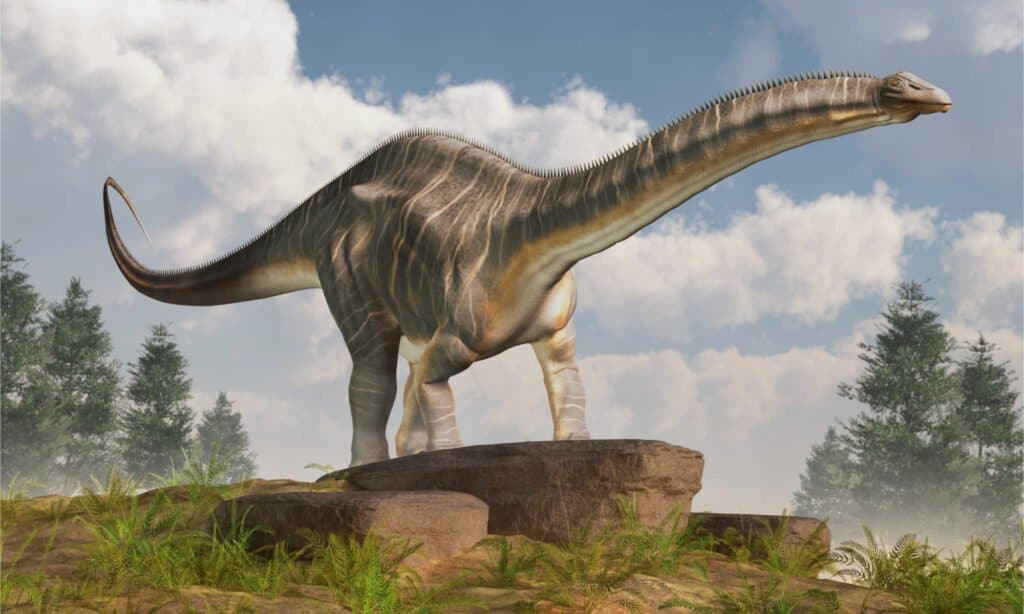
©Daniel Eskridge/Shutterstock.com
Where To See Fossils in Utah Today
Utah is a mecca for all things prehistoric. From museums to archaeological digs and even former dinosaur dwellings, Utah has it all — revealing the fascinating history of these creatures no matter where you go. Let’s look at a few of the incredible places where you can see fossils in Utah today!
Cleveland-Lloyd Dinosaur Quarry and Jurassic National Monument
The Cleveland-Lloyd Dinosaur Quarry is an active dig site that sits in the middle of the Jurassic Morrison Rock Formation. It has yielded some of the most important finds of its kind in history. Researchers have discovered over 12,000 bones there! From April through October, visitors can wander through rock art sites, dinosaur excavations, spectacular vistas, and intriguing geologic strata.
However, before braving the northern San Rafael Swell to visit the Quarry, remember to fill up your tank and bring a detailed map! The Swell is beautiful but remote. Temperatures can reach up to 100 degrees Fahrenheit, and it can be subject to flash flooding. So, keep an eye on the weather, stay away from washes, wear closed-toe shoes, and watch out for muddy, slick roads.
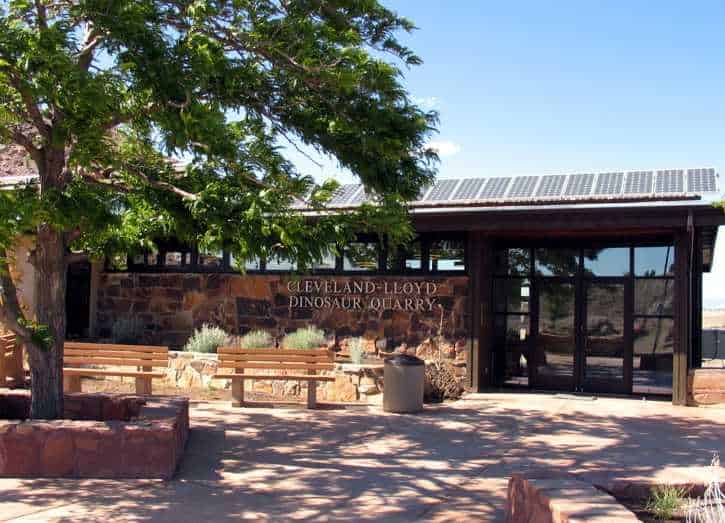
©Rmwarnick at English Wikipedia, Public domain, via Wikimedia Commons – License
“Dinosaurland” and the Dinosaur National Monument
Vernal, Utah, is often called “Dinosaurland” due to the incredible number of dinosaur fossils found here and in the surrounding Uintah Basin. At the Utah Field House of Natural History State Park Museum, visitors can explore and discover the fascinating history of this area. With 22,000 square feet of space dedicated to preserving ancient artifacts and providing insight into prehistory, this museum is a great place to learn more about Utah’s past. The outdoor Dinosaur Garden features replicas of prehistoric creatures as well.
Another major attraction is the Dinosaur National Monument, with over 200,000 acres of fossils, footprints, and other interesting prehistoric sites. The “Wall of Bones” here allows visitors to see over 1,500 fossils embedded in a natural, giant wall of rock! It is not curated like a paleontology museum. Instead, the fossils preserved and displayed in this massive wall were left behind by an ancient stream more than 150 million years ago! This special wall has remained untouched by any curator or paleontologist since its remarkable formation.
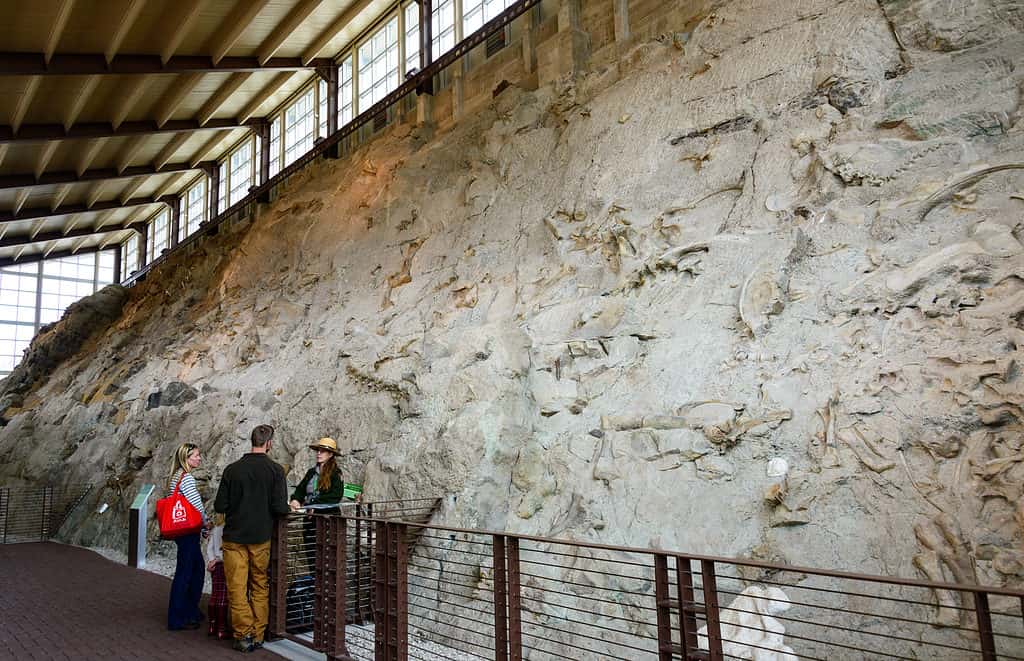
©Zack Frank/Shutterstock.com
Museum of Paleontology at Brigham Young University
With its fully immersive experiences, it’s no wonder that the Museum of Paleontology at Brigham Young University in Provo is such a popular destination. Visitors can explore the vast collection of dinosaur fossils, view interactive displays, and attend lectures and workshops on paleontology topics.
The museum’s viewing gallery provides an up-close look at how fossils are collected, studied, and prepared for display. Here visitors can watch students and scientists as they process and study fossils. In a special section of the museum, visitors can also touch the fossils and feel truly connected to the ancient past.
The Museum of Ancient Life at Thanksgiving Point
Another opportunity to step back in time and experience incredible fossils on display is at the Museum of Ancient Life in Lehi, Utah. There are so many fossils and dinosaur skeletons to see here, like the giant Supersaurus, the great Dimetrodon, the Allosaurus, the Ceratosaurus, the Dunkleosteus, and many more!
Kids can play paleontologist at the museum’s quarry dig, where they can dig for bones or cast and drill their own fossils to take home. At the Junior Paleo Lab, adults can observe the process of discovering dinosaur bones in real-time. The viewing gallery is also a great place for those interested in watching scientists hard at work unearthing ancient remains.
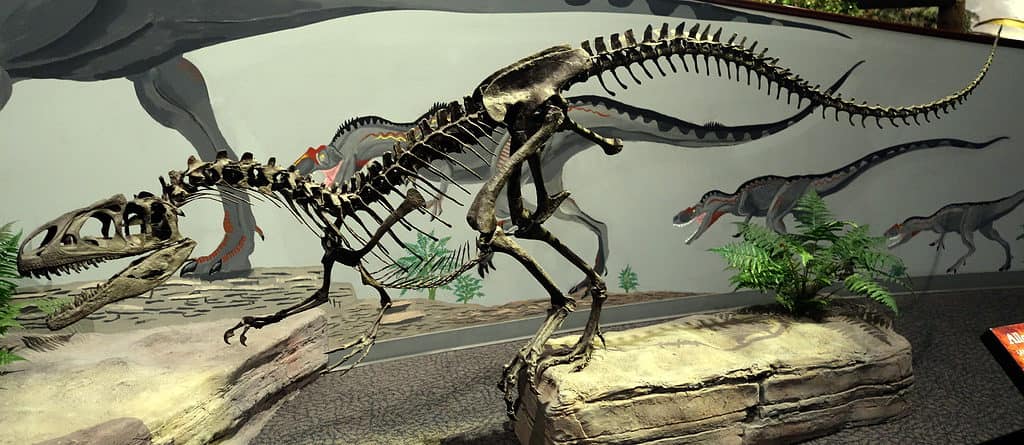
©Etemenanki3, CC BY-SA 4.0 <https://ift.tt/zfNXQh9>, via Wikimedia Commons – License
Delta, Utah
If you’re looking for a truly unique fossil-viewing experience, Delta is the place to go. It’s quite a long drive away from the Wasatch Front, down a passable and solid dirt road, but it’s well worth the trek. At the family-run operation, U-Dig Fossils, you get to be the paleontologist for the day, searching for real fossilized trilobites that you can keep and take home with you!
St. George Dinosaur Discovery Site
Situated in the southwestern corner of Utah, Lake Dixie was a lush paradise from the Early Jurassic Period. Its teeming waters and plentiful vegetation drew countless dinosaurs to its shores, providing them with a feast of large fish and edible plants. Today, the St. George Dinosaur Discovery Site allows visitors to explore this primeval environment. Visitors can view the fossilized remains of dinosaurs and other species from millions of years ago with life-sized models, working paleontologists on site, and many interactive activities.

©5of7, CC BY-SA 2.0 <https://ift.tt/6KyFPXc>, via Wikimedia Commons – License
George S. Eccles Dinosaur Park
Nestled in the foothills of Ogden, Utah, is the George S. Eccles Dinosaur Park. Visitors can explore a real dinosaur excavation site, complete with fossils and bone casts, as well as view life-sized replicas of other notable dinosaurs. Along with all this ancient fun, the park also offers hands-on activities such as fossil digging and interactive guided tours.
Dinosaur Diamond Highway
The Dinosaur Diamond Highway in Utah is a multi-day excursion and the perfect way to explore Utah’s dinosaur history. The journey provides visitors with many opportunities to visit numerous museums and to trek alongside dinosaur footprints left millions of years ago by massive plant-eating dinosaurs and fierce carnivorous creatures.
Along the Dinosaur Diamond Highway, you can see beautiful copper and crimson landscapes, stunning rock formations, reservoirs, and the Green River of Flaming Gorge National Recreation Area and Red Fleet State Park. Venture to the majestic San Rafael Swell, home to Jurassic National Monument and active dinosaur dig site. The trip ends in Moab, where you can explore the region’s real dinosaur tracks and marvel at life-sized reconstructions of dinosaurs at the Moab Giants Dinosaur Park & Museum.
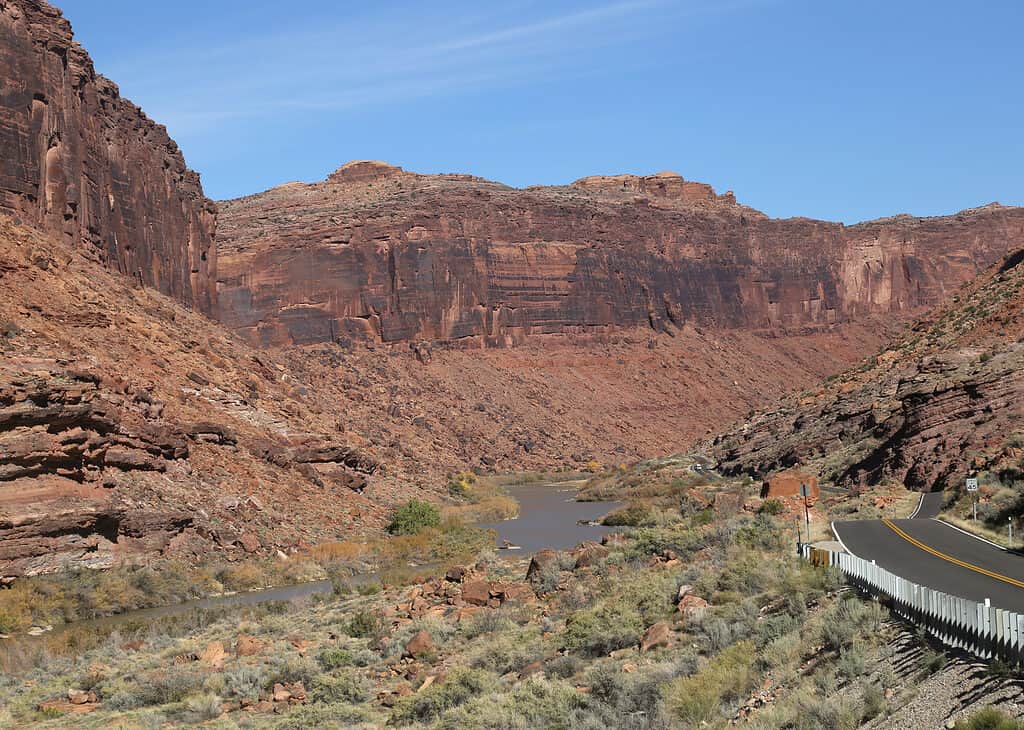
©vagabond54/Shutterstock.com
Blanding Dinosaur Museum
Nestled away in southeastern Utah is one of the state’s hidden gems, the Blanding Dinosaur Museum. The Blanding Dinosaur Museum is located at the southernmost point of the “Dinosaur Diamond” – an area that is renowned for its concentration of dinosaur activity and fossil discoveries. From fossils of dinosaur bones and eggs to remarkably preserved petrified trees and captivating film memorabilia, this museum is definitely worth seeking out.
Natural History Museum of Utah
Located in Salt Lake City, the Natural History Museum of Utah has amazing fossils from the Late Cretaceous Period in southern Utah, like the Wahweap, Kaiparowits, and Straight Cliffs formations. It also has incredible Upper Jurassic fossils from the Morrison Formation in central Utah, including the biggest collection from the famous Cleveland-Lloyd Dinosaur Quarry. The museum’s collection of plants from the Early Eocene Green River Formation in both Utah and Wyoming is fantastic, as well as its fossils from the Triassic period collected by a famous scientist named Dr. Sid Ash. The museum also houses important animal fossils and artifacts from Utah’s Pleistocene Period, the Pliocene Hagerman Fossil Horse Quarry, the Eocene Uinta Basin, and the Oligocene of Badlands National Park in South Dakota.
Utah State University Eastern Prehistoric Museum
At the Utah State University Eastern Prehistoric Museum in downtown Price is home to an astonishing 700,000+ archaeological artifacts, one of the premier collections in the United States. The museum houses real dinosaur bones and tracks from the very region where it is situated. Here you can marvel at amazing dinosaur specimens like the Tyrannosaurus, Utahraptor, and Allosaurus.
Fossilized Dinosaur Tracks in Utah
Have you ever dreamed of walking with dinosaurs? Well, there are several places in Utah where you can see and walk alongside actual dinosaur footprints, preserved from millions of years ago! Here are a few areas with fossilized dinosaur tracks to check out during your travels in Utah:
Twenty Mile Dinosaur Trackway
Step back in time with a trip to the Twenty Mile Dinosaur Trackway, just outside of Escalante, Utah. This trackway is a fossilized section of mudstone that holds over 350 dinosaur footprints! As you explore this incredible natural wonder in the remote wilderness of Utah, you can recognize individual tracks from three-toed dinosaurs to large sauropods.
Red Fleet Dinosaur Trackway
This 1.5-mile trek near Vernal, Utah, which takes you along a moderately rugged trail, is sure to thrill the dinosaur fanatic or casual hiker alike. At the end of the trail, be prepared to do a bit of work and uncover the tracks of a 200 million-year-old Dilophosaurus on the slick rock shores of the reservoir.
Moccasin Mountain Dinosaur Tracksite
On this 0.5-mile trail near Kanab, Utah, visitors can enjoy breathtaking sandstone cliffs and hundreds of dinosaur tracks with footprints from the Early Jurassic period. There are at least six different types of footprints you can look for here as you take in the stunning landscape of Moccasin Mountain.
Dinosaur Tracks Trail
The Dinosaur Tracks Trail near Moab, Utah, is a short and simple hike above the Colorado River. The hike features an incredible, tilted boulder face that holds ancient dinosaur trackways. Look for the flat, angled rock face perched on the skyline opposite the pit toilet and trailhead before embarking on your journey into this prehistoric world.
Copper Ridge Dinosaur Trackway
Located near Moab, Utah, the Copper Ridge Dinosaur Trackway is a great, 30-minute trek. Along this short hike, you can explore ancient tracks left by the Apatosaurus and Diplodocus. Just head south on U.S. 191 toward Moab and turn east at mile marker 148 onto a dirt road to reach the trailhead.
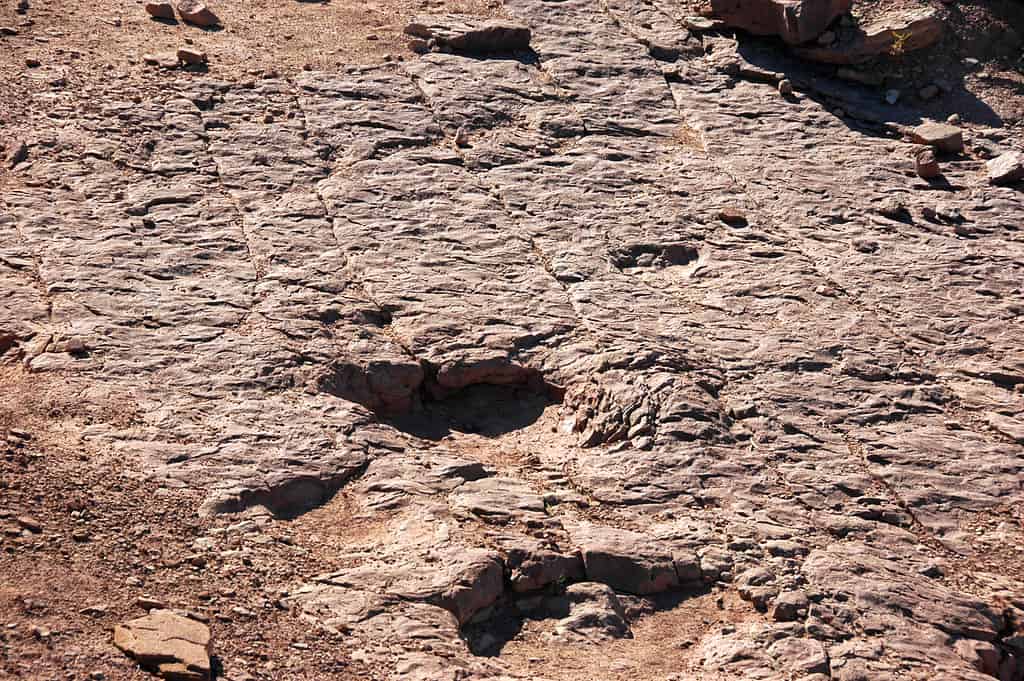
©James St. John / Flickr – License
Mill Canyon Dinosaur Trail
The Mill Canyon Dinosaur Trail is another short hike that features impressive sights like fossilized dinosaur bones, footprints, tracks, and wood. The trail is located 15 miles north of Moab, Utah. Take U.S. 191 and turn left at an intersection just north of highway mile marker 141. You’ll then cross some railroad tracks before continuing two miles down a bladed dirt road to the Trailhead. But be sure to check the road conditions before you go — it’s impassable when it’s wet!
Up Next
- Meet The Holy Grail of Ice Age Fossils: The La Brea Tar Pits
- Top 10 World’s Largest Dinosaurs Ever
- Discover 6 Extinct Animals That Lived in Utah
The post 10 Dinosaurs That Lived in Utah (And Where to See Fossils Today) appeared first on AZ Animals.
from Animal News, Facts, Rankings, and More! - AZ Animals https://ift.tt/j0RyYUa